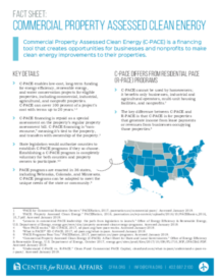Key details
• C-PACE enables low-cost, long-term funding for energy efficiency, renewable energy, and water conservation projects for eligible properties, including commercial, industrial, agricultural, and nonprofit properties. C-PACE can cover 100 percent of a project’s cost with terms up to 20 years.
• C-PACE financing is repaid as a special assessment on the property’s regular property assessment bill. C-PACE financing is “nonrecourse,” meaning it’s tied to the property, and transfers with ownership of the property.
• State legislation would authorize counties to establish C-PACE programs if they so choose. Establishing a C-PACE program is completely voluntary for both counties and property owners to participate.
• PACE programs are enacted in 36 states, including Nebraska, Colorado, and Minnesota. C-PACE programs can be adapted to meet the unique needs of the state or community.
C-PACE differs from Residential PACE (R-PACE) programs
• C-PACE cannot be used by homeowners; it benefits only businesses, industrial and agricultural operators, multi-unit housing facilities, and nonprofits.7
• The key difference between C-PACE and R-PACE is that C-PACE is for properties that generate income from lease payments or revenues from businesses occupying those properties.
C-PACE will benefit South Dakota’s economy
• C-PACE encourages businesses to invest in their area, creating jobs and using the local workforce to make energy-saving improvements to existing buildings or to build new buildings with energy-saving features.
• Nationally, South Dakota ranks 46th for energy efficiency programs and policy. C-PACE would give business owners an opportunity to finance much-needed energy efficiency updates and make money-saving investments in their properties.
• Annual energy savings for a C-PACE project are designed to exceed the annual assessment payment, allowing property owners to save money right away. Counties can encourage energy efficiency and renewable energy without putting general funds at risk.
• C-PACE can be combined with other energy efficiency incentives and rebates that are available through local utilities and state and federal programs. To find programs in your area, visit dsireusa.org.
Success stories
Rural states see large and small businesses benefiting from C-PACE
• Main Street Repeats, a thrift store located in Good Thunder, Minnesota (population 583), recently utilized C-PACE funding for an LED lighting project with a projected cost of $9,980. Owners utilized a rebate from their local utility, Xcel Energy, to save an additional $1,728, dropping the cost to $8,252. This improvement will result in $2,215 in estimated annual energy savings, and a total net savings of $19,979 over the life of the project.
• Bob and Steve’s Holiday gas station in Worthington, Minnesota (population 13,247), utilized C-PACE to install new LED lights, coolers and compressors, and HVAC. According to an energy audit, these projects have the potential to save a conservative estimate of $6,420 annually, which means a total savings of $96,316 in electricity costs over the 15-year loan.
• In December 2018, Petros PACE Finance, LLC, announced the closing of a $24.9 million transaction in Omaha, Nebraska, to redevelop a two-block site as part of an urban renewal effort for downtown Omaha. The project will fund C-PACE eligible upgrades for the $205 million mixed-use development called the Capitol District. The development includes a 333-room Marriott hotel, a 223-unit apartment building, and 90,000 square feet of retail space. The project will consist of energy efficiency measures that will generate substantial savings over the 22-year term of financing.


